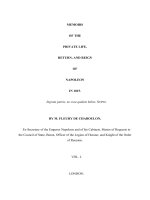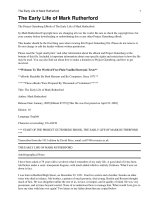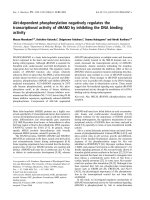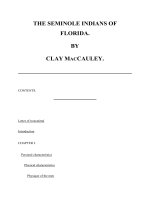Reactions the private life of atoms by peter atkins
Bạn đang xem bản rút gọn của tài liệu. Xem và tải ngay bản đầy đủ của tài liệu tại đây (4.16 MB, 200 trang )
REACTIONS
This page intentionally left blank
Reactions
the private life of atoms
by PETER ATKINS
1
3
Great Clarendon Street, Oxford OX2 6DP
Oxford University Press is a department of the University of Oxford.
It furthers the University’s objective of excellence in research, scholarship,
and education by publishing worldwide in
Oxford New York
Auckland Cape Town Dar es Salaam Hong Kong Karachi
Kuala Lumpur Madrid Melbourne Mexico City Nairobi
New Delhi Shanghai Taipei Toronto
With offices in
Argentina Austria Brazil Chile Czech Republic France Greece
Guatemala Hungary Italy Japan Poland Portugal Singapore
South Korea Switzerland Thailand Turkey Ukraine Vietnam
Oxford is a registered trade mark of Oxford University Press
in the UK and in certain other countries
Published in the United States
by Oxford University Press Inc., New York
© Peter Atkins Limited 2011
The moral rights of the author have been asserted
Database right Oxford University Press (maker)
First published 2011
All rights reserved. No part of this publication maybe reproduced,
stored in a retrieval system, or transmitted, in any form or by any means,
without the prior permission in writing of Oxford University Press,
or as expressly permitted by law,or under terms agreed with the appropriate
reprographics rights organization. Enquiries concerning reproduction
outside the scope of the above should be sent to the Rights Department,
Oxford University Press, at the address above
You must not circulate this book in any other binding or cover
and you must impose the same condition on any acquirer
British Library Cataloguing in Publication Data
Data available
Library of Congress Cataloging in Publication Data
Data available
Printed & bound in China
by C&C Offset Printing Co Ltd
ISBN 978-0-19-969512-6
1 3 5 7 9 10 8 6 4 2
contents
Preface
PART I
1.
2.
3.
4.
5.
6.
7.
8.
9.
10.
11.
12.
A Preliminary Remark: Water and Friends
Matter Falling Out
Give and Take
Burns Night
Back to Basics
Two Hands Clapping
Electric Occurrence
The Generation Game
The Death of Metal
Civil Partnerships
Changing Partners
Marriage Broking
Divorce and reconciliation
PART II
13.
14.
The Basic Tools
Assembling the Workshop
Stringing Along
Snapping Together
1
3
11
14
26
33
37
47
54
61
67
76
81
88
95
97
102
15.
16.
17.
18.
19.
20.
21.
22.
Missile Deployment
Electronic Warfare
Fasteners
Zippers
Adding Up
Taking Away
Carbon Footprints
Networking Opportunities
VI
CON T EN T S
PART III
23.
24.
25.
26.
Making Light Work
Dark Matter
Irritating Atmospheres
Seeing the Light
Green Chemistry
PART IV
Building by Design
27. Food for Thought
28. Grand Designs
PART V
Glossary
Index
Economizing
106
113
120
129
133
136
139
142
146
149
152
155
157
161
163
171
175
179
186
preface
At the heart of chemistry lie reactions. When chemists shake, stir,
and boil their various fluids, they are actually coaxing atoms to form
new links, links that result in forms of matter that perhaps have never
existed before in the universe. But what is actually going on? What
form does that coaxing take? How, using the laboratory equivalents of
using shovels and buckets, are individual, invisible, submicroscopic
atoms urged into new partnerships?
Chemistry is thought to be an arcane subject, one from which
whole populations seems to have recoiled, and one that many think
can be understood only by the monkishly initiated. It is thought to be
abstract because all its explanations are in terms of scarcely imaginable atoms. But, in fact, once you accept that atoms are real and imaginable as they go about their daily lives, the theatre of chemical change
becomes open to visualization.
In this book I have set out to help you understand and visualize the
private lives of atoms to that when you look at chemical change—and
chemical change is all around and within us, from the falling of a leaf
through the digestion of food to the beating of a heart and even the
forming of a thought, let alone the great industrial enterprises that
manufacture the modern world—you will be able to imagine what is
going on at a molecular scale. In the sections that follow, I invite you to
PREFACE
VIII
imagine constructing a toolbox of fundamental processes which will
enable you to imagine levering one atom away from its partner and
encouraging it to join another. Then, with those basic tools in mind, I
help you to establish a workshop where you will assemble to tools and
bring them to bear on a variety of projects. Finally, I introduce you,
in outline but not in detail, to how those workshops are invoked to
engineer certain grand projects of construction.
The representation of atoms and molecules is fraught with danger
and the representation of the changes they undergo is even more hazardous. I have used drawings of molecules, cartoons really, that chemists typically used to represent their ideas, and have tried to represent
various quite complicated processes in a simple and direct manner.
Detail and sophistication, if you want them, can come later from other sources: I did not want them to stand in the path of this introduction and encouragement to understanding. My aim is not so much to
show you exactly what is going on during a reaction but to invite you
into the possibility of thinking about the private lives of atoms in a
visual way, to show that chemistry is indeed all about tangible entities
with characteristics that are the equivalent of personalities and which,
like human personalities, lead them into a variety of combinations.
I wrote and illustrated the text myself. For reasons related to how
the illustrations would lie on the page I also needed to set the pages.
In that process I had a lot of help from the editorial and design departments of my publishers, who also took my necessarily somewhat
amateurish raw efforts and refined them into the current version. I am
very grateful to them; having gone through the entire process of constructing a book, except for its actual printing, I can appreciate even
more their skills.
PWA
March, 2011;
the International Year of Chemistry
I
THE BASIC TOOLS
I
n this section I introduce you to the hammers, spanners, and
chisels of chemistry. Here you will meet the basic types of chemical reaction that underlie all the processes around us, the processes of industry, the processes of life and death, and the processes
that chemists seek to induce in their bubbling flasks. They are all the
basic tools used for the fabrication of different kinds of matter.
The difference between real tools and a chemist’s tools, is that
the latter are exquisitely refined, for they need to shift atoms around.
To make a new form of matter, perhaps one that does not exist
anywhere else in the universe or simply to satisfy an existing demand, a chemist needs to be able to cajole, induce, tempt, batter,
urge individual atoms to leave their current partners in one substance and join those from another substance. The new linkages
must also be organized in specific ways, sometimes in assemblages
2
RE AC T IONS
of great intricacy. In this way from raw material new matter emerges.
Of course, chemists do not do this atomic disassembling and reassembling atom by individual atom: they do it by mixing, heating,
and stirring their multicoloured liquids, vapours, and solids. Yet beneath these large-scale activities, the myriad atoms of their mixtures
are responding one by one. Knowing what happens on the scale of
atoms will help you understand what mixing, boiling, and stirring are
bringing about. So, in each case I shall show you what is happening to
the atoms when a common technique, a basic tool, is employed.
In later parts I shall assemble all these individual basic tools into
a metaphorical chemical workshop, and then take you out to reveal
construction sites of extraordinary beauty.
A Preliminary Remark
water and friends
W
ater is the most miraculous of fluids. As well as being
ubiquitous on Earth and essential for life as we know it,
it has remarkable properties which at first sight don’t
seem to be consistent with its almost laughably simple chemical composition. Each molecule of water consists of a single oxygen atom (O)
and two hydrogen atoms (H); its chemical formula is therefore, as just
about everyone already knows, H2O.
Here is one odd but hugely important anomalous property. A
water molecule is only slightly heavier than a methane molecule (CH4;
C denotes a carbon atom) and an ammonia molecule (NH3, N denotes
a nitrogen atom). However, whereas methane and ammonia are
gases, water is a liquid at room temperature. Water is also nearly
unique in so far as its solid form, ice, is less dense than its liquid form,
so ice floats on water. Icebergs float in water; methanebergs and
ammoniabergs would both sink in their respective liquids in an
extraterrestrial alien world, rendering their Titanics but not their
Nautiluses safer than ours.
Another very important property is that water is an excellent solvent, being able to dissolve gases and many solids. One consequence
of this ability is that water is a common medium for chemical reactions. Once substances are dissolved in it, their molecules can move
reasonably freely, meet other dissolved substances, and react with
them. As a result, water will figure large in this book and this preliminary comment is important for understanding what is to come.
The water molecule
4
RE AC T IONS
1
You need to get to know the H2O molecule intimately,
y,
for from it spring all the properties that make water so
miraculous and, more prosaically, so useful. The molecule also figures frequently in the illustrations, usually looking
kin like
1, where the red sphere denotes an O atom and the pale grey spheres
represent H atoms. Actual molecules are not coloured and are not
made up of discrete spheres; maybe 2 is a better depiction, but it is less
informative. I shall use the latter representation only when I want to
draw your attention to the way that electrons spread over the atoms
and bind them together.
Each atom consists of a minute, positively
charged nucleus surrounded by a cloud of negatively charged electrons. These atomic electron clouds
2
merge and spread over the entire molecule, as in 2,
and are responsible for holding the molecule together in its characteristic shape. A detail that will prove enormously significant throughout this book is that a bond between an O atom and an H atom, which
is denoted O–H, consists of just two electrons. That two-electron
character is a common feature of all chemical bonds.
5
A PREL IMINARY REM ARK
The most important feature of an H2O molecule
for what follows is that although it is electrically neutral overall, the electrical charge is not distributed
uniformly. It turns out that the O atom is slightly
3
negatively charged and the H atoms each have a
slight positive charge, 3. Throughout this book, when it is necessary
to depict electric charge I shall represent positive charge by blue and
negative charge by red. You need to distinguish these colour depictions from those I use to denote atoms of different elements, such as
red for oxygen and blue for nitrogen! The slight negative charge of the
O atom, which is called a ‘partial charge’, arises from an accumulation of the electron cloud on it. The electrons are drawn there by the
relatively high charge of oxygen’s nucleus. That accumulation is at the
expense of the hydrogen atoms, with their relatively weakly charged
nuclei. At their positions the cloud is depleted and the positive charge
of their nuclei shines through the thinned cloud and gives them both
a partial positive charge.
As a result of the attraction between oppo4
site partial charges, one H2O molecule can stick
(loosely, not rigidly) to neighbouring H2O molecules, and they in turn can stick to other neighbours. The mobile swarm of molecules so formed
constitutes the familiar wet fluid we know as ‘water’. This behaviour is in contrast to that of methane. Not only does a
CH4 molecule, 4, have much smaller partial charges because the nucleus of a C atom is more weakly charged than that of an O atom, but
the partial charge of the C atom is hidden behind
the surrounding four H atoms, 5. As a result, CH4
molecules stick together only very weakly, and at
room temperature methane is a gas of independent, freely moving, widely separated molecules.
5
FIG. 1 Liquid water
6
RE AC T IONS
Liquid and solid water
Let’s consider the swarm of molecules that
makes up liquid water. A glance at Figure 1
shows the kind of molecular arrangement you
should have in mind when thinking about the pure
liquid. Think of the image of being only a single frame of a
movie: the molecules are in fact in ceaseless motion, tumbling over
and over and wriggling past their neighbours.
When water freezes, this motion is stilled and the molecules settle
down into a highly ordered, largely stationary arrangement (Figure
2). Each molecule is still attracted to its neighbours by the attraction between opposite partial charges, but now they adopt an open
honeycomb-like structure, just rocking quietly in place, not moving
past one another. Melting is the collapse of this structure when the
rocking motion becomes so vigorous as the temperature is raised that
the molecules start to move past their neighbours and the open structure collapses. As a result of the relatively open molecular structure
of ice compared to the collapsed molecular rubble of liquid water,
ice is less dense than water and so can float on its own liquid.
Dissolving
I have remarked that water is a remarkably good solvent. Substances
as different as salt and sugar dissolve in it readily. The oceans are great
repositories of dissolved matter, including the gases that make up the
atmosphere. The power of water to dissolve also springs
from the presence of small electric charges on its
molecules.
To understand the role of electric charges
in this connection, you need to know that a
substance like common salt, sodium chloride
FIG. 2 Ice
FIG. 3 Solid sodium chloride
FIG. 4 Dissolved sodium chloride
A PREL IMINARY REM ARK
(NaCl), consists of myriad ‘ions’, or electrically charged atoms, stacked together in a
vast array and held together by the powerful attraction between their opposite charges
(Figure 3). Common salt is therefore an example
of an ‘ionic compound’. In its case, each sodium ion
has a single positive charge (blue) and is denoted Na+; each
chlorine ion has a single negative charge (red) and is denoted Cl–. A
sodium ion is formed by the loss of a single electron from a sodium
atom, and a chlorine ion (more formally, a ‘chloride’ ion) is formed by
the acquisition of that electron by a chlorine atom. When you pick up
a grain of salt, you are picking up more ions than there are stars in the
visible universe.
Water molecules can form a ‘fifth column’ of subversive infiltrators
between ions and bring about the downfall of an ionic solid (Figure
4). The partial positive charges on the H atoms can simulate the full
positive charge of a sodium ion, especially when several water molecules are present, and as a result a chloride ion can be seduced into
leaving its sodium neighbours. Likewise, the partial negative charge
of each O atom of several water molecules can simulate the full negative charge of a chloride ion, and seduce a sodium ion into leaving its
chloride ion neighbours. Thus, the sodium and chloride ions can be
induced to drift off into surrounding water. Dissolution is seduction
by electrical deception.
Not all ions can be fooled by water in this way. In
some cases the electrical attraction between
neighbouring ions is just too strong to be
simulated by the relatively weak interaction of the partial charges of some H2O
molecules. The ions remain faithful to
one another, withstand the seduction
of partial charges, and the substance
7
RE AC T IONS
8
is insoluble. This is the case with silver chloride (AgCl, Figure 5; Ag
is the symbol for silver, argentum), an insoluble white solid. Much of
our landscape survives because water is unable to dissolve the rocks.
All rocks, though, are slightly soluble, and water can erode them and
thereby fashion the landscape into valleys and deep canyons.
ons.
Not all compounds are ionic. Water is an example of a ‘covalent compound’ in which the atoms are held to one another by the electron cloud
that spreads over them, as I explained above. Later
6
in the book I shall introduce you more fully to
the so-called ‘organic molecules’, which are molecules of covalent
compounds built principally but not solely from carbon. Organic
molecules, which are so-called because they were once erroneously
thought to be made only by living organisms, typically also contain
hydrogen and commonly oxygen and nitrogen. An example is ethanol, ordinary ‘alcohol’, CH3CH2OH, 6. Incidentally, this formula is
an example of how chemists report the composition of a molecule
not just by showing how many atoms of each element are present,
as in C2H6O, but also hinting at how they are grouped together.
You should compare the formula CH3CH2OH with the structure to
identify the CH3 group, the CH2 group, and the OH group.
Although a lot of organic molecules do dissolve in water (think
sugar), a lot don’t (think oil). The difference can be traced in
large measure to the fact that if atoms other than C and H are
present, then the molecules have partial
7
charges that can be
emulated by water. That is the case
with sugar. Glucose, for instance,
is C6H12O6, 7. If only C and H are
present, as is the case with hydroFIG. 5 Solid silver chloride
FIG. 6 Alcohol (ethanol)
A PREL IMINARY REM ARK
carbon oils, 8, then the partial charges are so
weak that water cannot seduce them.
Moreover, water is actually chemically
aggressive, and can react with and destroy the
compounds dissolved in it. Cooks use that characteristic to release flavours and break down cell walls.
Many organic compounds, however, do dissolve in other and
less chemically
mically aggressive
ag
organic liquids, so many of the reactions
characteristic of organic chemistry are car8
ried out in organic solvents such as alcohol
(Figure 6). At this stage all you need is to be
alert to that feature, and I shall expand on it
when more detail is needed.
9
This page intentionally left blank
1
Matter Falling Out
precipitation
I
shall now introduce you to one of the simplest kinds of chemical reaction: precipitation, the falling out from solution of newly formed solid, powdery matter when two solutions are mixed
together. The process is really very simple and, I have to admit, not
very interesting. However, I am treating it as your first encounter
with creating a different form of matter from two starting materials,
so please be patient as there are much more interesting processes to
come. I would like you to regard it as a warming-up exercise for thinking about and visualizing chemical reactions at a molecular level. Not
much is going on, so the steps of the reaction are reasonably easy to
follow.
There isn’t much to do to bring about a precipitation reaction. Two
soluble substances are dissolved in water, one solution is poured into
the other, and—providing the starting materials are well chosen—an
12
RE AC T IONS
FIG. 1.1 Sodium chloride solution
insoluble powdery solid immediately
forms and makes the solution cloudy. For
instance, a white precipitate of insoluble
silver chloride, looking a bit like curdled
milk, is formed when a solution of sodium
chloride (common salt) is poured into a solution of silver nitrate.
Now, as we shall do many times in this book, let’s imagine
shrinking to the size of a molecule and watch what happens when
the sodium chloride solution is poured into the sil1
ver nitrate solution. As you saw in my Preliminary remark, when solid sodium chloride dissolves in water,
Na+ ions and Cl– ions are seduced by water molecules
into leaving the crystals of the original solid and spreading through
the solution (Figure 1.1). Silver nitrate is AgNO3; Ag denotes a silver
atom, which is present as the positive ion Ag+; NO3– is a negatively
charged ‘nitrate ion’, 1. Silver nitrate is soluble because
2
the negative charge of the nitrate ion is spread over
its four atoms rather than concentrated on one, 2, as
it is for the chloride ion, and as a result it has rather
weak interactions with the neighbouring Ag+ ions in the solid. For
the same reason, the smeared out charge of the nitrate ion and its
consequent weak attraction for neighbouring positively charged
ions, most nitrates are soluble regardless of their accompanying
positive ions. In the second solution, Ag+ and NO3–
ions are dispersed among the water molecules,
just like in a solution of sodium chloride
(Figure 1.2).
As soon as the solutions mix and the
ions can mingle (Figure 1.3), the strong
electrical attraction between the op-
FIG. 1.2 Silver nitrate solution
FIG. 1.3 The solutions mixing
FIG. 1.4 Silver chloride precipitating
M AT T ER FAL L ING OU T
positely charged Ag+ and Cl– ions draws
them together into little localized solid
clumps, a powder. To us molecule-sized
observers, the tiny particles of powder
are like great rocks smashing down around
us, thundering down from the solution overhead (Figure 1.4). The weak interactions between
the Na+ ions and the smeared out charge of the
NO3– ions are not strong enough to result in them clumping
together: they remain in solution as a solution of soluble sodium
nitrate.
Precipitation reactions are about as simple as you can get in
chemistry, the chemical equivalent of wife-swapping without the
moral hesitation. Nevertheless, they can be useful. Commercial
examples of precipitation reactions are the preparation of silver
chloride and its cousins silver bromide and silver iodide for photographic emulsions. The bright yellow pigment ‘chrome yellow’
is formed by a precipitation reaction in which a solution of lead
nitrate (a soluble white solid) is mixed with a solution of sodium
chromate, when insoluble yellow lead chromate precipitates leaving
sodium nitrate in solution. On almost the very last page of this
book you will see how a precipitation reaction can be used in the
synthesis of a highly important drug.
13
2
Give and Take
neutralization
T
he almost infinite can spring from the almost infinitesimal.
Two almost infinitesimally small fundamental particles are of
considerable interest to chemists: the proton and the electron.
As to the almost infinite that springs from them, almost the whole
of the processes that constitute what we call ‘life’ can be traced to the
transfer of one or other of these particles from one molecule to another in a giant network of reactions going on inside our cells. I think
it quite remarkable, and rather wonderful, that a hugely complex network of extremely simple processes in which protons and electrons
hop from one molecule to another, sometimes dragging groups of atoms with them, sometimes not, results in our formation, our growth,
and all our activities. Even thinking about proton and electron transfer, as you are now, involves them. Here I consider the transfer of a
proton in some straightforward reactions in preparation for seeing
later, in the second part of the book, how the same processes result in
eating, growing, reproducing, and thinking. For reactions that involve
the transfer of electrons, see Reaction 5.
Meet the proton
GIV E A ND TAKE
What is a proton? For physicists, a proton is a minute, positively
charged, very stable cluster of three quarks; they denote it p. For
chemists, who are less concerned with ultimate things, a proton is the
nucleus of a hydrogen atom; they commonly denote it H+ to signify
that it is a hydrogen atom stripped of its one electron, a hydrogen ion.
I shall flit between referring to this fundamental particle as a proton
or a hydrogen ion as the fancy takes me: they are synonyms and the
choice of name depends on convention and context.
An atom is extraordinarily small, but a proton is about 100 000
times smaller than an atom. If you were to think of an atom as being
the size of a football stadium, then a proton would be the size of a fly
at its centre. It is nearly 2000 times as heavy as an electron. Nevertheless, a proton is still light and nimble enough to be able to slip reasonably easily out from its home at the centre of a hydrogen atom in some
types of hydrogen-containing molecules. Having escaped, it can stick
to the electron clouds of certain other molecules, cloak itself with a
shared pair of their electrons, and become a hydrogen atom attached
to that other molecule. There, in a nutshell, is the topic of this section:
proton transfer, the escape of a proton from one molecule and its capture by another. Why I have used the term ‘neutralization’ in the title
will become clear very soon.
Physicists discovered the proton in 1919 although the concept had
been lurking in their general awareness ever since Ernest Rutherford
(1871–1937) had shown in 1911 that an atom was mostly empty space
with a central core, the nucleus. The structure of an atomic nucleus
soon became clear: it was found to consist of a certain number of
15
16
RE AC T IONS
protons and the proton’s electrically neutral cousin, the neutron. By
1913 Henry Moseley (1887–1915, shot at Gallipoli by protons bundled
together as iron nuclei) had determined the numbers of protons in the
nuclei of the atoms of many elements. Thus, a hydrogen nucleus is a
single proton, there are two protons in the nucleus of helium, three in
lithium, 26 in iron, and so on.
Chemists brought protons fully into their vocabulary in 1923 but
had unwittingly been shuttling them around between molecules of
various kinds, thinking of them as ‘hydrogen ions’, since the nineteenth century. Artisans and cooks had been shuttling them around,
even more unwittingly, for centuries.
A little light language
I need to step back a few years to put the proton into a chemical context for you. As I remarked in the preface, chemists are always on
the lookout for patterns, both patterns in the properties of the elements and patterns in the reactions that substances undergo. It had
long been familiar to them and to their predecessors the alchemists
that certain compounds react together in a similar way. Two of these
groups of compounds that reacted together in a certain pattern came
to be known as ‘acids’ and ‘alkalis’. Because this reaction seemed
to quench the acidity or alkalinity of the participants, it came to be
known as ‘neutralization’.
Chemists also noted that the product of a neutralization reaction
between an acid and an alkali is a salt and water. A ‘salt’ takes its name
from common salt (sodium chloride) but might be composed of other
elements. Chemists often take the name of a single exemplar and use
it to refer to an entire class of similar entities. A salt is an ionic compound, like sodium chloride (recall Figure 3 of my Preliminary remark),
that is neither an acid nor an alkali.
Let’s focus initially on acids and alkalis. The name ‘acid’ is derived









